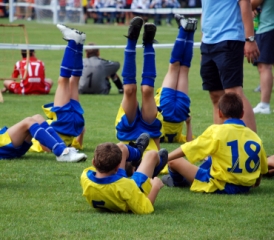Dynamic Stretching Best for Sports Warmup
When your child begins a new sport season, especially if they haven't played that sport in a while, some of their muscles, tendons, ligaments, and joints may need a little extra to help them perform at their best and decrease their risk of injury.
Sports medicine and health professionals, including Certified Athletic Trainers, Personal Trainers, Certified Strength and Conditioning Specialists, and physicians, have not always agreed on the best way to properly warm up prior to beginning sports or exercise.
For many years, the conventional wisdom was that the best pre-activity routine was what is now called static stretching: stretching and lengthen muscle groups by holding them in a stretched - or static - position for approximately 20 to 30 seconds. An example would be a runner stretching to touch their fingers to their toes and holding that position for a certain length of time to stretch/relax the hamstrings and quadriceps.
Another popular form of stretching is so-called ballistic stretching, which isolates individual muscles in a lengthened position while the muscle is quickly shortened and lengthened. For example, bouncing up and down at the trunk when performing straight leg toe touches.
A growing body of clinical research, however, suggests that static stretching, far from being the best way for athletes to warm up and prepare for the stress and strain sports and exercise puts on their bodies, may actually increase the risk of injury by prompting a reflexive reaction to the stretching to protect the muscle and joints, which then leads to temporary weakness of the muscle group being stretched.
Dynamic warm-up
Dynamic warm-up is a technique used to increase total body blood flow and uses major joints such as hips and shoulders in a total range of motion. This technique is done while the body is in motion and the muscles, ligaments, tendons, and joints are being moved and blood flow is flowing.
Some examples of dynamic exercises are:
- Full Squats
- Leg Swings

- Scorpions
- Walking Lunges
- Arm Circles (Narrow and Wide)
Dynamic stretching has the following benefits:
- Increases total body blood flow
- Boosts flexibility
- Improves balance
- Increases muscle endurance
- Opens up joints
- Increases heart rate
- Excites the nervous system
Soft Tissue Manipulation
Soft tissue manipulation is a form of muscle massage designed to restore the full function and length of a muscle.
It has the following benefits:
- Improves mobility by releasing trigger points or "knots"
- Increases localized blood flow
- Loosens adhesions in connective tissue that could bind muscle
- Stimulates the nervous system to assist in relaxing the muscle so the muscle works more efficiently during activity.
The great thing about soft tissue manipulation is that an athlete can perform it themselves by lying on a foam roller or hard ball, such as a tennis or lacrosse ball, with the weight of their body on the target muscle group, and then moving slowly over the foam roller or ball to massage the entire length of muscle group being targeted.
Any muscle that the athlete feels is tight or has trigger points can benefit from soft tissue mobilization, but the technique works best on the larger muscle groups in the body, including the following:
- Quadriceps (the four large muscles in the front of the thigh; which are the strongest and leanest muscle in the human body)
- IT Bands (tough groups of fibers that run along the outside of the thighs which function primarily as a stabilizer during running)
- Lattisimus Dorsi (large, flat muscles at the back of the shoulders)
- Glutes/Piriformis (muscles of the buttocks and upper thigh/hip)
- Low Back.
Improved performance
The bottom line: before your young athlete plays sports or exercises, suggest that they combine dynamic stretching and soft tissue manipulation beforehand for improved performance and efficiency.
For more MomsTeam videos featuring Eric Laudano, click here.
Revised December 27, 2011
- 9814 reads
- Flag as offensive
- Printer-friendly version








